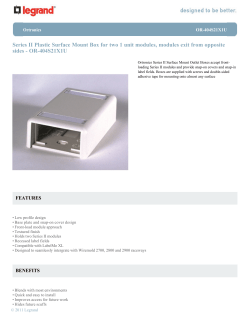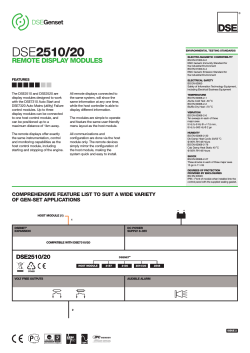
The VCX Story - Accedian Networks
White paper The Story How Accedian's physical network performance assurance instrumentation became virtualized (using NFV) without any loss of performance or functionality. 2Q 2015 Our customers were facing new performance assurance problems. Problems that required low cost, but highly precise instrumentation to turn up and monitor small cells, branch office business services and data center connectivity. They needed all the features we had in our Network Performance Elements, but sized and priced to fit these costcompetitive business models. So we turned to Network Function Virtualization, or NFV, to create a completely new form of instrumentation. Because of the way our units are designed, it was easy for our engineers. But to keep it confidential, we did this work at a remote location. At the Accedian Demolition Lab (secret location), an engineer prepares to cut a Network Performance Element into its function components, as described below. The units have a CPU, which handles test control and reporting functions, and an FPGA processor that does all the ultraprecise test measurements and traffic processing. The CPU is connected to the FPGA and the traffic ports through an Ethernet bus on our motherboard. We virtualized the units by basically slicing off the CPUs and centralizing these functions in a controller software program you can run in the cloud, or on any off the shelf Linuxbased server. Then we broke off the ports with their own FPGA processors, so that we could create ultra-compact units to install wherever testing is needed, without the size and cost of a unit with its own CPU, power supply, and so on. Accedian Network Performance Element cut apart into CPU, power supply and ports, which became… ...the VCX solution: ultra-compact units for ports, and centralized CPU controller software Then we patented a way to replace the Ethernet bus with a lossless connection protocol that lets these pieces live physically far apart without losing any data, control or functionality. We polished things with our family of Modules: our Nano smart SFP for optical connections, and the ant Module for copper connections. The VCX Story • 2Q 2015 Our VCX Controller performs the CPU functions for thousands of remote Modules. It basically combines the CPUs of all the units into a single piece of software. In our lab, we did this using the VCX Virtualizer: We took the CPU power from our Network Performance Elements, blended it up, and cooked it with a special “Virtualizer” recipe to create the VCX Controller software. The result is simple: we ported the full 10 years of Accedian innovation into a new, cost-effective, highly scalable format. We didn’t start from scratch like many companies have to with their products. We simply cut up what we already had—tried, tested and true. It’s virtualized instrumentation — without compromise. The VCX Story • 2Q 2015 Highlights • No NFV expertise required to use • VCX located remotely from The SkyLIGHT™ VCX - A Technical Tour Accedian standalone NIDs (Network Performance Elements) have been transformed into a piece of software (the VCX Controller)—a virtual appliance, and miniature Modules that act as remote ports throughout the network. The NID’s CPU (control plane) and FPGA (data/test processing plane) functions have been separated. The control pane is the part that was virtualized into the VCX Controller. modules in COTS server or cloud • One VCX virtual appliance can control thousands of remote modules • Modules don’t need any pre-config before use • Since features are now developed largely in software, it’s easy for Accedian engineers to add new ones The FPGA inside each module is equivalent in processing power to the one used in our standalone units (FPGAs also follow Moore’s law, and are now much more powerful and smaller than ever). This ensures that our virtualized solution offers the same performance, precision, and capabilities as the NIDs. Related Resources About VCX The VCX Controller uses a patented, lossless tunnel to maintain the link between the VCX and the Modules, over any kind of network. • Video: Making of the VCX • Video: VCX – How It Works • Product Brief: SkyLIGHT VCX Controller • Datasheet: SkyLIGHT VCX The solution retains all the attributes of standalone NIDs, including the same graphical user interface (GUI), same command-line interface (CLI), results retrieval, and Element management system (EMS) integration. They are fully interoperable. Service providers don’t need to change any operational procedures, or support systems to start using them. You can think of it as a new way to package our existing products. You don’t need any NFV or data center expertise to use these solutions in a production environment, or even just to try it out in the lab. The Modules need no pre-configuration when deployed. Everything is handled by Accedian’s Plug & Go zero-touch provisioning protocol. They can be installed directly by the end-customer. Managing the devices is very easy, as a single login lets you control thousands of remote modules from a single GUI. The features are highly extensible, as each performance assurance application uses its own virtual network function (VNF), so features can be developed and pushed to the programmable Modules remotely. © 2015 Accedian Networks Inc. All rights reserved. Accedian Networks, the Accedian Networks logo, SkyLIGHT, AntMODULE, Vision EMS, Vision Suite, VisionMETRIX, Vision Collect, Vision Flow, Vision SP, V-NID, Plug & Go, R-FLO, Network State+, Traffic-Meter, FlowMETER & ant Module are trademarks or registered trademarks of Accedian Networks Inc. All other company and product names may be trademarks of their respective companies. Accedian Networks may, from time to time, make changes to the products or specifications contained herein without notice. Some certifications may be pending final approval, please contact Accedian Networks for current certifications. The VCX Story • 2Q 2015 2
© Copyright 2025










